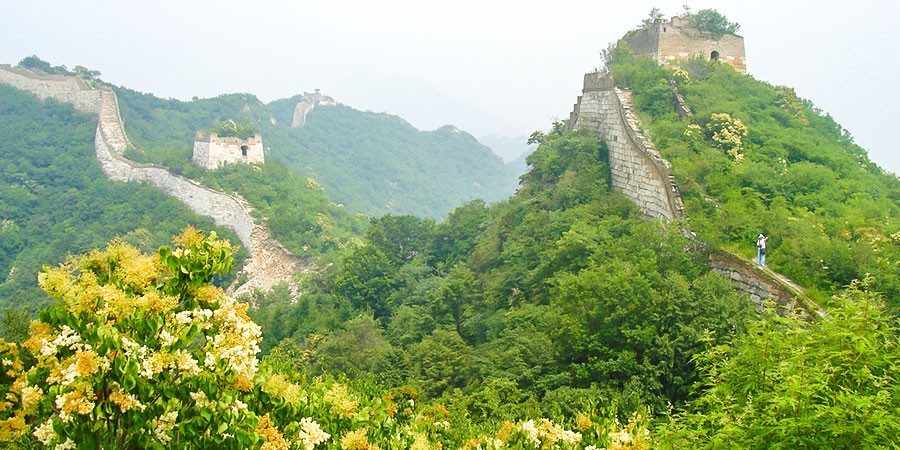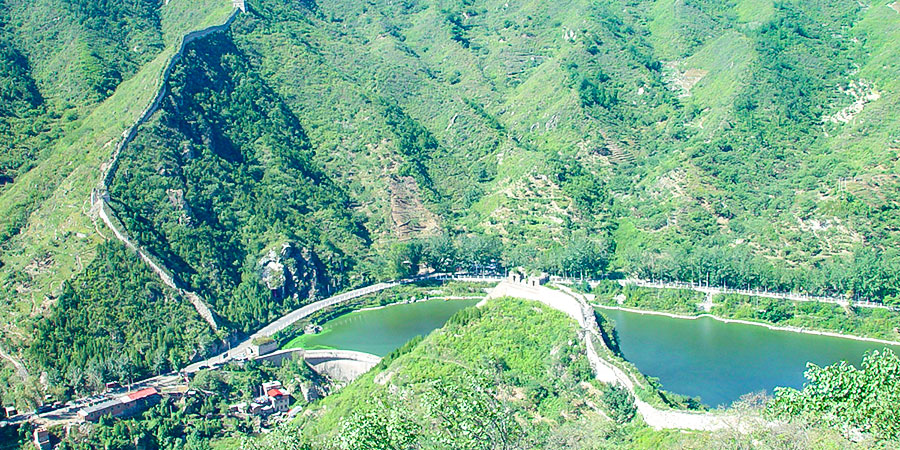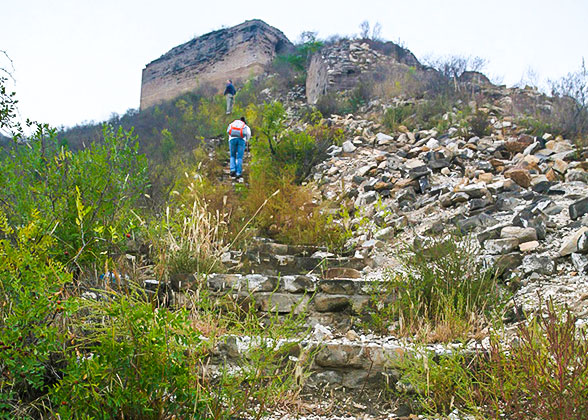Wild Great Wall in Beijing
Wild Great Wall is a collective name for those sections retaining their original appearance with either slight or none renovation. Although broken, visitors can truly feel the vicissitudes of history and steps of time there. They are also great destinations for hikers and adventurous travelers. The famous destinations for a wild Great Wall tour in Beijing include Jiankou, Huanghuacheng, Gubeikou, and Lupiguan.
Jiankou Great Wall (Arrow Nock Great Wall)
 |
Climbing Difficulty:
Convenience of Public Transportation:
Due to its unique style, steep mountains, and beautiful scenery, Jiankou is a photographic hotspot and popular travel destination. 'Jiankou', translated as 'Arrow Nock', is so named because the shape of the mountain is like an arrow, with the collapsed ridge opening as its arrow nock. Jiankou was an important section built in the Ming Dynasty (1368 - 1644). Zigzagging 12 miles (20 kilometers) on a lofty mountain ridge, it is also one of the most dangerous sections. Built of large pieces of white dolomite, the wall is striking from a distance.
![]() Further Reading: Jiankou Hiking
Further Reading: Jiankou Hiking
 |
Climbing Difficulty:
Convenience of Public Transportation:
Huanghuacheng is the only section in Beijing that is by a lake. Water separates the wall into three segments with a small part of it submerged. Surrounded by green mountains with a clear lake along the wall, it presents a unique scene combining the desolation of the frontier with the beauty of nature. You can take a boat ride on the lake and view the Great Wall at the same time. It is also a great destination for family and friends to have fun: have a picnic, go fishing, and even throw a barbecue party.
![]() Further Reading: Huanghuacheng Hiking
Further Reading: Huanghuacheng Hiking
 |
| Gubeikou Great Wall |
Climbing Difficulty:
Convenience of Public Transportation:
The Gubeikou section preserves segments from two dynasties. First constructed in the Northern Qi Dynasty (550 – 577), it was renovated in the Ming Dynasty, retaining some original parts. Leaning against Wohu Mountain and Panlong Mountain, it was of great strategic importance. Starting from the Liao Dynasty (907 – 1125), it was the site of many wars, making it a famous ancient battle field.
![]() Further Reading: Gubeikou Hiking
Further Reading: Gubeikou Hiking
Climbing Difficulty:
Convenience of Public Transportation:
Lupi Pass was one of the most important Great Wall passes built in the Ming Dynasty. Located on the ridges of a valley with the Baihe River flowing by, it was easy to hold but hard to attack. Now, however, only ruins and a few towers remain on the top of the mountains.
More Wild Sections in Beijing
Wild Great Wall Travel Tips - Top Dos and Don'ts
| Dos | Don'ts |
|---|---|
| Check the weather before your visit. | Don't go there when it rains, snows, or thunders. |
| Water-resistant, breathable, and windproof clothes, and hiking boots are the best outfit. You'd better take a mountaineering stick. It is a good helper to save energy while climbing. | Short sleeves, breeches, and sandals do not provide good protection and may result in your being scratched by weeds and sticks. Since some parts are been badly damaged with remnants and gravels on the road, you may get injured wearing sandals. |
| Take a compass or hand-held GPS to help you find your way in the absence of obvious direction signs. Or you can find a local resident who is familiar with the path as your guide. | Don't walk around randomly, or you may get lost. |
| Finish your hike before dark. | Don't stay there until the sunset. It's easy to lose your way and there is no light along the wall. |
| Find yourself some companions. | Don't try this alone. |
| Pack some snacks, there is no shop or booth up there. | Don't eat wild fruits along the path, they could be poisonous. |
| Bring plenty of water. The walls were built on mountains, making it very difficult to find drinkable water. | Don't gulp water. |
| Choose safe paths and watch your step. Use both your hands and feet to get through steep segments. | Don't try any dangerous moves while climbing. |
| In some difficult segments, you may find some cloth strips on the tree branches or arrows on the ground. They are signs made by other hikers, pointing out the safer path, which you may follow. | Don't walk along untrodden paths. |
| If you want to take pictures, make sure you are safely grounded. | Don't try any dangerous posses. |